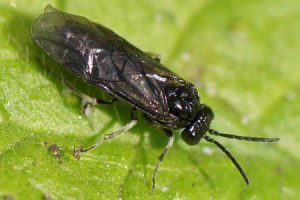 Sawflies can cause serious damage to your garden. These pests in their larvae stage feed on leaves, leaving only the veins when they are done. Adults live for only about two weeks but they mate and lay enough eggs in the tissues of plants to continue their cycle of destruction.
Sawflies can cause serious damage to your garden. These pests in their larvae stage feed on leaves, leaving only the veins when they are done. Adults live for only about two weeks but they mate and lay enough eggs in the tissues of plants to continue their cycle of destruction.
But how can you get rid of these pests? First, you need to know what sawflies are.
What are Sawflies?
Sawflies are insects closely related to bees and wasps. As adults, they are very inconspicuous with bodies measuring about 1/5 of an inch. Though they look like wasps or bees, sawflies do not sting. Adults usually have black and red coloration while sawflies in their larvae stage display various colors depending on their species. They also have 4 distinct wings.
The pear sawfly (Caliroa cerasi) is common both in the Unites States as well as Canada. Like most sawflies, its larvae looks like hairless caterpillars. They feed on flowering pear, plum, and cherry plants.
The larvae in its youngest stages is elongated and looks very much like a slug. As it matures, however, it begins to resemble a moth caterpillar. Sawflies in the larvae stage are much bigger than their adult counterparts, usually measuring about ½ inch on average.
When you see leaves in your garden that are almost completely transparent, with only their veins remaining, you can almost bet it’s the work of sawflies. You may notice larvae on the edges of leaves feeding on your plants while adult sawflies feed on pollen or nectar. In some cases, you might also notice caterpillar-like creatures in the fruits your garden plants produce. The fruits will have a scared appearance and ooze fluid.
How to Treat a Sawfly Infestation
On the occasion that a sawfly infestation occurs in your garden, you will need to apply different measures depending on the type of sawfly present. Some of the best measures include the following:
- Inspect garden regularly for signs of sawflies
Since larvae often appear during late spring, it is best to begin your inspection from around May. Be sure to inspect trees and garden plants regularly to increase the likelihood of spotting sawflies early as this will make it possible for you to eradicate them with less effort.
- Remove larvae by hand to reduce damage to plants
If you spot larvae on leaves, especially in the early stages of an infestation, remove them by hand. Sawfly slugs usually feed in groups and at this stage will not be too difficult to remove since they’ll be limited in number.
Be sure to wear gloves if you are squeamish around insects, though. Also, note that when disturbed sawfly larvae make an S-shape. They will curl into this shape, raising their rear ends in the process. There is little need to fear though as they do not bite.
- Relocate damaged plants to open areas where predators can feed on young sawflies
If possible, for instance in the case of potted plants, relocate plants affected by sawfly larvae into an area free of excess trees and branches. Once these plants are in an open area, birds will be able to access a delectable meal as they swoop down to eat your garden pests.
Other predators such as wasps and beetles will also enjoy eating these pests, depending on the type of sawfly present and the life cycle stage it is in.
- Use chemicals to reduce sawfly population if serious infestation occurs
Chemicals are known to be an effective solution for sawflies. Infestation should best be treated by a professional however as pest control experts will be able to access the seriousness of the infestation as well as determine the type (s) of sawflies present. The treatment methods they suggest will, therefore, be best suited to address your specific pest problem.
How to Prevent Sawflies from Damaging Plants in your Garden
The average sawfly pest will not cause serious damage to your garden unless the right conditions are present for an infestation. To reduce your risk, apply the following preventative measures:
- Keep your garden in good condition
Sawflies are most likely to cause serious problems in your garden where weak or untreated plants are present. Address this issue by taking steps to ensure your plants are healthy.
- Take care of plants that are newly transferred or planted
Young or tender plants are more susceptible to sawfly damage than mature plants. For this reason, place special attention on meeting the needs of the most vulnerable plants in your garden.
For further information you may be interested in these articles:
How to Spot Signs of Amphipod Infestation
How to Get Rid of Firebrats in Your Closet
Are Chinch Bugs Causing Damage to Your Lawn?

No Comments